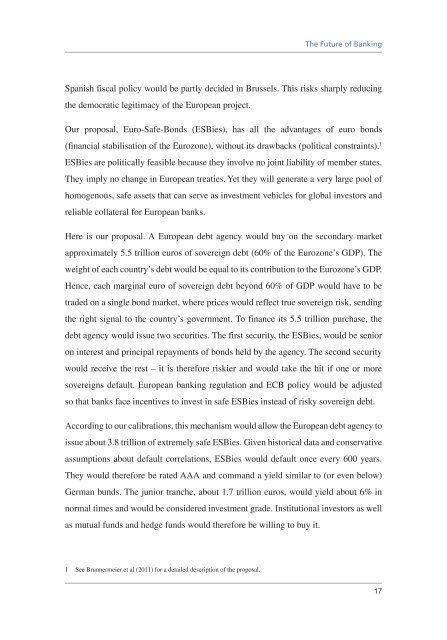You also want an ePaper? Increase the reach of your titles
YUMPU automatically turns print PDFs into web optimized ePapers that Google loves.
The Future of Banking<br />
Spanish fiscal policy would be partly decided in Brussels. This risks sharply reducing<br />
the democratic legitimacy of the European project.<br />
Our proposal, Euro-Safe-Bonds (ESBies), has all the advantages of euro bonds<br />
(financial stabilisation of the Eurozone), without its drawbacks (political constraints). 1<br />
ESBies are politically feasible because they involve no joint liability of member states.<br />
They imply no change in European treaties. Yet they will generate a very large pool of<br />
homogenous, safe assets that can serve as investment vehicles for global investors and<br />
reliable collateral for European banks.<br />
Here is our proposal. A European debt agency would buy on the secondary market<br />
approximately 5.5 trillion euros of sovereign debt (60% of the Eurozone’s GDP). The<br />
weight of each country’s debt would be equal to its contribution to the Eurozone’s GDP.<br />
Hence, each marginal euro of sovereign debt beyond 60% of GDP would have to be<br />
traded on a single bond market, where prices would reflect true sovereign risk, sending<br />
the right signal to the country’s government. To finance its 5.5 trillion purchase, the<br />
debt agency would issue two securities. The first security, the ESBies, would be senior<br />
on interest and principal repayments of bonds held <strong>by</strong> the agency. The second security<br />
would receive the rest – it is therefore riskier and would take the hit if one or more<br />
sovereigns default. European banking regulation and ECB policy would be adjusted<br />
so that banks face incentives to invest in safe ESBies instead of risky sovereign debt.<br />
According to our calibrations, this mechanism would allow the European debt agency to<br />
issue about 3.8 trillion of extremely safe ESBies. Given historical data and conservative<br />
assumptions about default correlations, ESBies would default once every 600 years.<br />
They would therefore be rated AAA and command a yield similar to (or even below)<br />
German bunds. The junior tranche, about 1.7 trillion euros, would yield about 6% in<br />
normal times and would be considered investment grade. Institutional investors as well<br />
as mutual funds and hedge funds would therefore be willing to buy it.<br />
1 See Brunnermeier et al (2011) for a detailed description of the proposal.<br />
17














